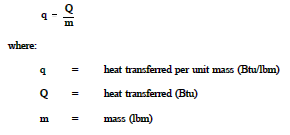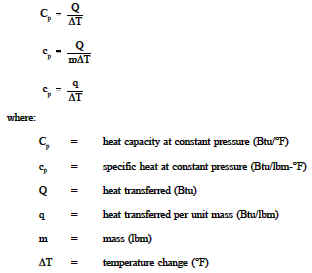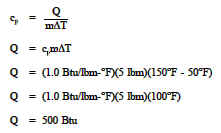Heat Energy Thermodynamic Properties
Thermodynamics Directory | Heat Transfer Directory
Heat Energy
Heat, like work, is energy in transit. The transfer of energy as heat, however, occurs at the molecular level as a result of a temperature difference. The symbol Q is used to denote heat. In engineering applications, the unit of heat is the British thermal unit (Btu). Specifically, this is called the 60 degree Btu because it is measured by a one degree temperature change from 59.5 to 60.5°F.
As with work, the amount of heat transferred depends upon the path and not simply on the initial and final conditions of the system. Also, as with work, it is important to distinguish between heat added to a system from its surroundings and heat removed from a system to its surroundings. A positive value for heat indicates that heat is added to the system by its surroundings. This is in contrast to work that is positive when energy is transferred from the system and negative when transferred to the system. The symbol q is sometimes used to indicate the heat added to or removed from a system per unit mass. It equals the total heat (Q) added or removed divided by the mass (m). The term "specific heat" is not used for q since specific heat is used for another parameter. The quantity represented by q is referred to simply as the heat transferred per unit mass.

Example:
Determine the heat transferred per unit mass if 1500 Btu’s are transferred to 40 lbm of water.
Solution:
Using Equation 1-16

The best way to quantify the definition of heat is to consider the relationship between the amount of heat added to or removed from a system and the change in the temperature of the system. Everyone is familiar with the physical phenomena that when a substance is heated, its temperature increases, and when it is cooled, its temperature decreases. The heat added to or removed from a substance to produce a change in its temperature is called sensible heat. The units of heat are often defined in terms of the changes in temperature it produces.
Another type of heat is called latent heat. Latent heat is the amount of heat added to or removed from a substance to produce a change in phase. When latent heat is added, no temperature change occurs. There are two types of latent heat. The first is the latent heat of fusion. This is the amount of heat added or removed to change phase between solid and liquid. The second type of latent heat is the latent heat of vaporization. This is the amount of heat added or removed to change phase between liquid and vapor. The latent heat of vaporization is sometimes called the latent heat of condensation.
Different substances are affected to different magnitudes by the addition of heat. When a given amount of heat is added to different substances, their temperatures increase by different amounts. The ratio of the heat (Q) added to or removed from a substance to the change in temperature (ΔT) produced is called the heat capacity (Cp) of the substance. The heat capacity of a substance per unit mass is called the specific heat (cp) of the substance. The subscript p indicates that the heat capacity and specific heat apply when the heat is added or removed at constant pressure.
![]()

One lbm of water is raised 1°F and one Btu of heat is added. This implies that the specific heat (cp) of water is one Btu/lbm-°F. The cp of water is equal to one Btu/lbm-°F only at 39.1°F.
By rearranging Equation 1-17 we obtainQ=mcpΔT, which is used to calculate latent heat. By
substituting mass flow rate in lbm/hr, m, for m, we obtain Q ![]() pmcp ΔT. This equation is used˙to calculate heat transfer in Btu/hr and will be useful in later chapters.
pmcp ΔT. This equation is used˙to calculate heat transfer in Btu/hr and will be useful in later chapters.
Example:
How much heat is required to raise the temperature of 5 lbm of water from 50°F to 150°F? (Assume the specific heat (cp) for water is constant at 1.0 Btu/lbm-°F.)
Solution:

From the previous discussions on heat and work, it is evident that there are many similarities between them. Heat and work are both transient phenomena. Systems never possess heat or work, but either or both may occur when a system undergoes a change of energy state. Both heat and work are boundary phenomena in that both are observed at the boundary of the system. Both represent energy crossing the system boundary.